We at ModestFish are always trying to give our readers the most accurate and up to date information that we can when it comes to aquarium care and equipment.
To that end, we decided to go really in depth and create a head-to-head comparison to find the best aquarium heater .
Most aquarists don’t have the time, money or inclination to buy multiple heaters and figure out which one works the best. They just have to buy one and hope for the best.
So, we did the footwork for you so you have the best possible information before you spend your hard earned cash.
After a whole lot of research, I bought the Fluval E200, Hygger, Fluval M200, Ehiem, and HITOP and carried out experiments in one of my own home aquariums to see which is the safest and most accurate to use.
Here are my results:
Best Aquarium Heater Winner: Fluval E Series
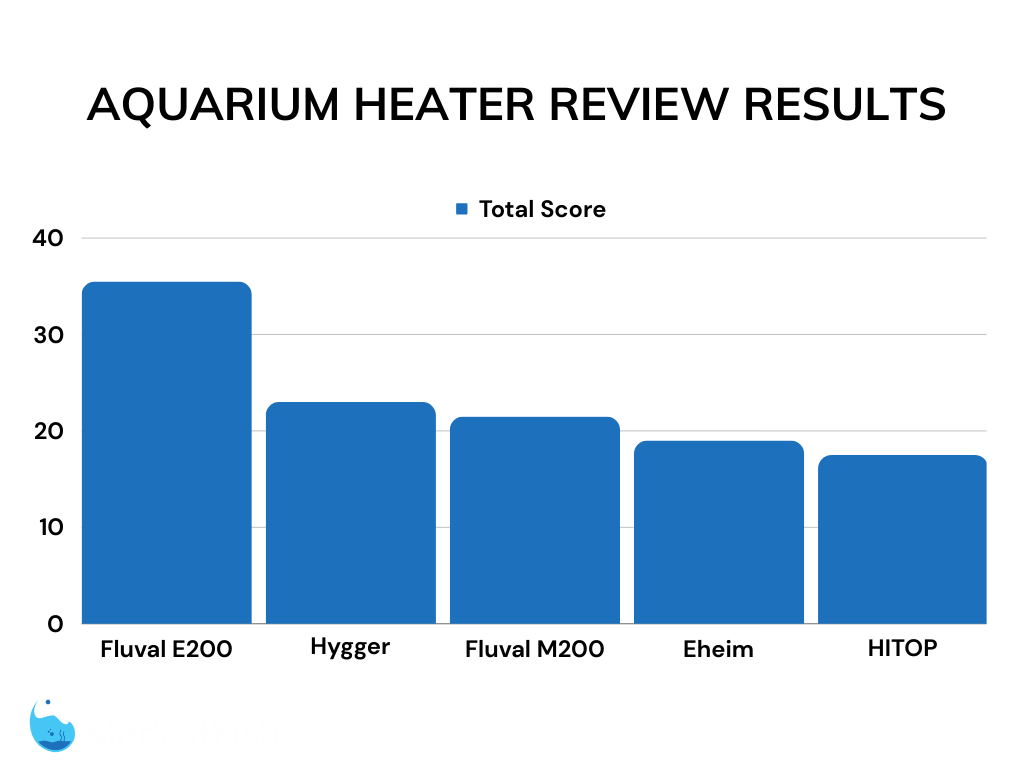
Fluval E Series (Best & Safest Overall Heater)
What I like about Fluval’s E Heater Series
The Fluval E200 is the most accurate & safe heater I tested. It’s available in 3 sizes: 100, 200, and 300 watts.
Out of the heaters I tested, it was the set-it-and-forget-it model. I really like its built-in heater guard, making it a safe and reliable heater you can count on.
Also, I love the digital display that lets you know whether it’s in standby or heating mode and will even alert you if there is a serious temperature problem in the tank.
That could be the difference between averting disaster and losing a tank full of fish.
If your tank is bigger or smaller than a 55 gallon, no problem! Fluval makes several different sizes of E heaters for you to choose from.
Pros & Cons
Pros
Easy to read digital display
Sturdy, built-in heater guard
Display flashes if tank is too hot/cold by 5.5°F
3-way indicator light
Cons
No dry sensor
Internal heater tube is made of glass

Overall Score: 4.5/5
In-depth Scoring
Installation: 5/5
Calibration: 5/5
Consistency: 5/5
Readability: 5/5
Durability: 3/5
Indicator Light: 5/5
Overheat/Dry Sensor: 2.5/5
Heater Guard: 5/5
Best Aquarium Heaters Compared & Reviewed
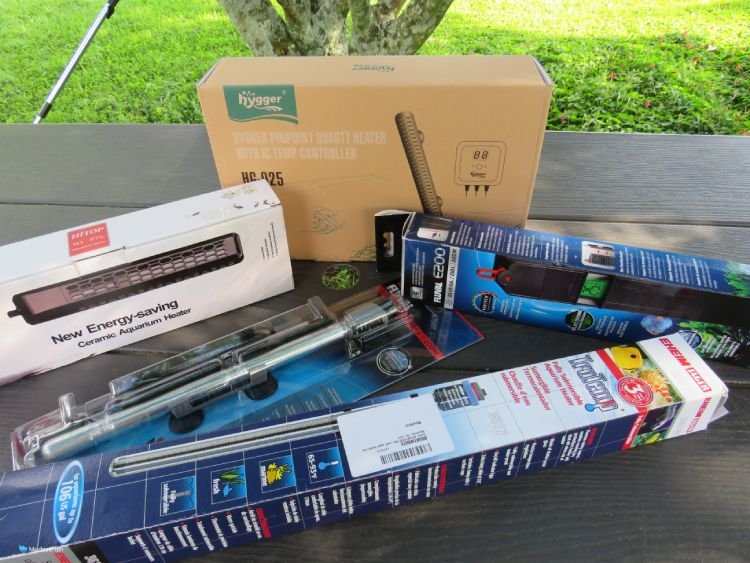
I purchased the Fluval E200, Hygger, Fluval M200, Eheim, and HITOP aquarium heaters, tested them for accuracy, safety and every day use to see which one is best.
Here are the results:
1. Fluval E200 Electronic Heater (Top Pick)
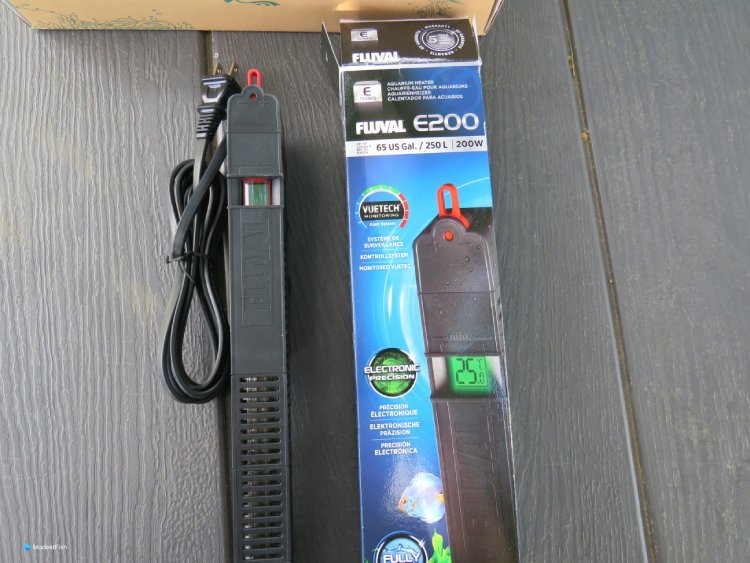
Installing this heater was a breeze. The suction cups on this thing are amazingly strong. You can adjust the height of the bracket that the suction cups attach by simply squeezing the sides of the heater, just below the digital display.
You do need to be careful about placement. This heater is meant to have the top ½ inch (1.25 centimeters) of the heater out of the water. But, the nifty sliding bracket makes this easy to accomplish.
This heater is designed to be attached to the back wall of your tank, but if you need to attach it to a side wall, a bracket for side mounting is included.
But, you cannot install this heater in a horizontal position since this would submerge the entire body of the heater. The red switch at the top is waterproof, but not designed to stay submerged full time.
The E200 comes preset to 77°F (25°C), but it’s simple to adjust the temp. There is a red lever at the top of the heater, you simply toggle it left to decrease the temperature or right to increase it.
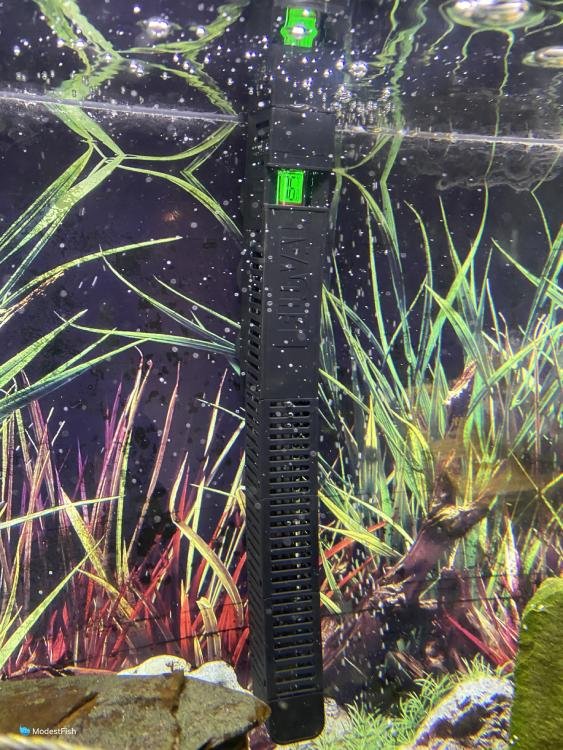
I really love the digital display on this heater. Not only does it make it super easy to set the temperature, but it also displays the current water temperature in real time. Also, if the water temp goes 5.5°F above or below the set temperature, the display will flash to help alert you to the problem.
The display also functions as an indicator light. During normal standby mode, the LCD screen will be green. If the temp has dropped below the set temp, it will turn blue to indicate that the heating element has turned on. If the temp becomes higher than what’s set, the LCD will turn red.
I’ve had trouble while running this test with some heaters being a bit underpowered, especially if they have a built in heater guard.
However, that is not the case with this E200. It easily holds the water at 75°F.
Calibration was very simple. I set the heater to 75°F and that was it. It just steadily kept the water nice and toasty, just the way I wanted it.
I was able to just set it and forget it. So nice!
I love the built-in heater guard. You can really feel the quality of the dense plastic when you hold it in your hand.
I didn’t have to worry that my fish would accidentally touch the heating element at all.
I only have two little things to complain about.
First, the heating tub underneath the heater guard is made of glass. This makes it vulnerable to cracking or shattering.
Be especially careful when you take this heater out of the water. If the heating tube is hot, and it is suddenly taken out of the water, it could crack.
Also, this heater does not have a dry sensor. The instructions emphasize repeatedly that this heater should never be allowed to run out of the water.
If it is allowed to run outside of the water, unplug it and let it cool for at least an hour. Putting the heater back into the water while it’s super hot could cause the glass tube to shatter (this is true of any glass or ceramic heater).
But honestly, all of the good points of this heater far outweigh any negatives. This is my top choice out of all the heaters I tried for this experiment. I highly recommend it.
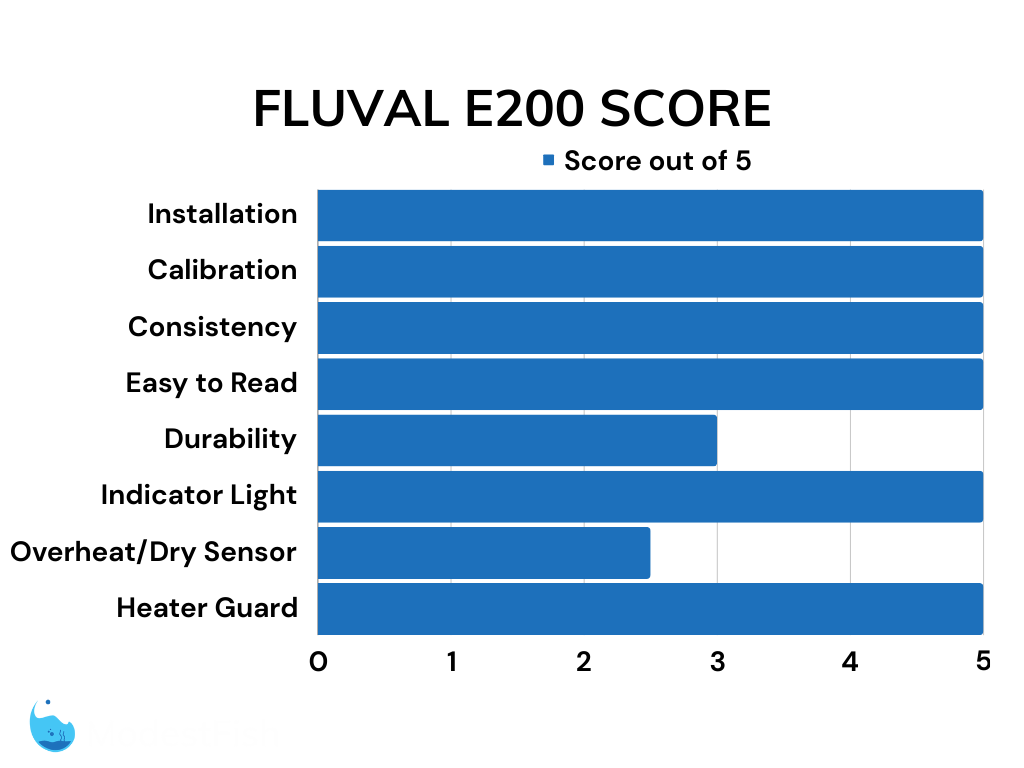
Pros:
- Easy to read digital display
- Sturdy, built-in heater guard
- Display flashes if tank is too hot/cold by 5.5°F
- Simple installation with powerful suction cups
- 3-way indicator light that shows active heating mode, standby mode or overheat alert
- Set it and forget it calibration
Cons:
- No dry sensor
- Internal heater tube is made of glass

Last update on 2024-04-25 / Commissions Earned / Images from Amazon Product Advertising API
Read Our Full In-depth Review For The Fluval E200 Here
2. Hygger 200W Digital Quartz Aquarium Heater
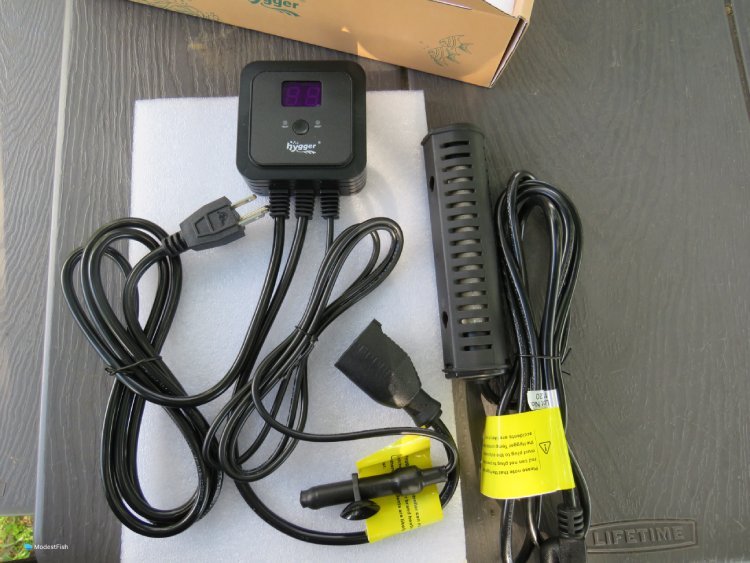
This heater is a bit different than the others on the list. Instead of just a single, self-contained unit, this heater is made up of three parts:
- Heating unit
- Temperature probe
- Control unit
The heating unit looks just like any other aquarium heater, although it is much smaller than most aquarium heaters. It comes with it’s own built-in heater guard that will protect fish from touching the actual heating element and burning themselves.
The temperature probe sits at the end of a thick wire that you suction cup to the back of the tank. It’s basically a temperature sensor that sends information to the control unit.
The control unit has a display that shows the current temperature of the tank. The temperature probe is hardwired into the control unit, but the heating unit actually plugs into it with the same kind of pronged plug you’d use with an electrical wall outlet.
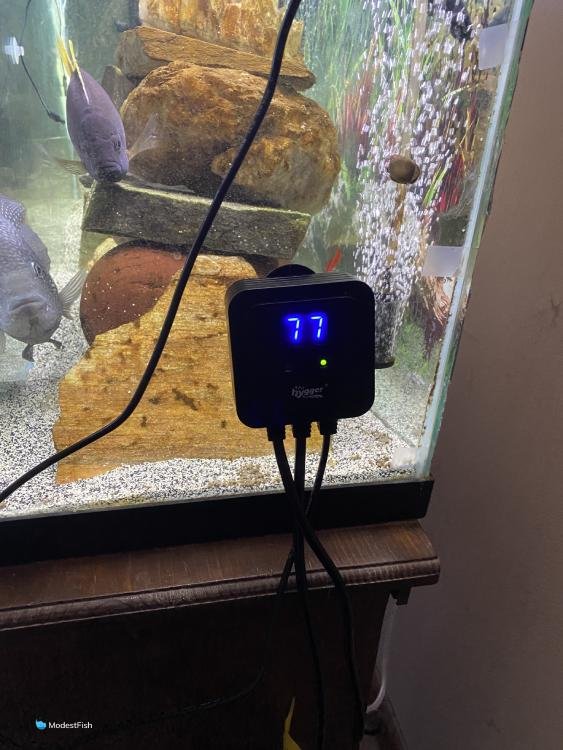
The control unit turns power on and off to the heating unit. Without the control unit, the heating element would just stay on continuously and overheat the tank. Never use the heating unit without the control unit!
I also had to knock off points for durability. Underneath the heater guard is a glass heater. The guard should help protect the glass somewhat from accidental bumps, but the glass is still vulnerable to cracking from things like rapid temperature changes.
This heater does have an overheat sensor, but I still gave it a ranking of only 1. The overheat sensor will not shut the heater down until the water temperature reaches 97°F (36°F). Any fish in the tank would be long dead before the water reached this temperature.
Also, the sensor doesn’t seem to detect when the heater is running outside of the water since there are so many reports of this heater melting if it runs outside the tank.
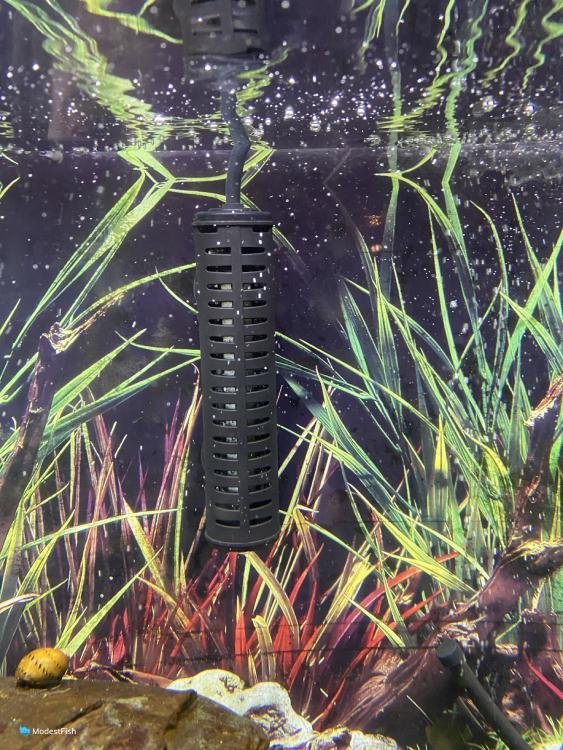
Installing this heater takes a little more work because you have to mount all three parts. The temp probe and the heating unit are easy to suction cup to the inside of the tank.
But, mounting the control unit is a major pain. It’s supposed to suction cup to the side of the tank but I’ve had nothing but bad luck with this.
The suction cup for the control module is the same as the ones that you use to attach the heating unit inside the tank. The ones inside the tank work great, but it just is not strong enough to hold up the surprisingly heavy control until
I have two of these heaters and the suction cups for both control units just will not stay put. They’ll stick to the glass when you first set the heater up, but after a few days, it will fall off and keep falling off.
I solved this in both cases by mounting a plastic thumb tack either on the wall behind the tank or on the side of the wooden tank stand. Not the most elegant solution, but it’s simple and you can’t see the thumb tack behind the control module.
Also, despite being rated as a 200 watt heater, the Hygger Quartz heater struggled to maintain a consistent temp in my 55 gallon (it does great in my 40 gallon). There’s tons of water flow in this tank, and frankly, I’ve not had this issue with other 200 watt heaters.
To get the tank to maintain at 75°F, I had to bump up the temp on the control unit to 77°F. I did have to fiddle with it twice after installing to bump up the temp (I would give it four hours and then check back on the temp).
And it still didn’t ever warm the tank to exactly 75°F, it was either a bit too warm or a bit too cool. And because you can only change the temp setting by whole degrees, there’s no way to tweak it further.
So, I really like the design with the built in heater guard, but this model does have some issues that knock it down in the ratings.

Pros:
- Takes up less room
- Built in heater guard
- Easy to set temp
- Indicator light for both standby and active heating modes
Cons:
- Outside suction cup not strong enough
- Extremely difficult to calibrate
- Somewhat inconsistent temperature
- Overheat cut off takes place at too high a temp
- No dry sensor

Last update on 2024-04-25 / Commissions Earned / Images from Amazon Product Advertising API
Full review for the Hygger 200W Digital Quartz Aquarium Heater
3. Fluval M200 Submersible Heater

I have a lot of experience with this particular heater. I’ve owned several Fluval M heaters, of various sizes, over the years.
Installation is really easy, the mounting bracket with suction cups is already attached to the heater tube.
All you have to do is open the package and stick the heater to the back glass, easy peasy.
I do have to knock it a little bit on durability because it is a glass heater, although as of now, I’ve never cracked one of these.
The glass has a mirror finish that is supposed to let it blend in better and be less noticable. I can’t really attest to that, I can totally still see that the heater is in the tank.
Of course, this is completely subjective, but I think that the mirror finish and slim profile do lend the M200 a fancy, modern look that I really like.

Sadly, no built in heater guard for this model. However, since it’s so nice and slim, you can fit it with an aftermarket heater guard, if you would like.
This heater has a nice, clear temperature dial on the top of the heater.
I had to fiddle with the calibration a little bit, but all it took were two tries and then I got it to hold the water at a steady 75°F.
This heater does have an indicator light, but only for active heat mode, not standby.
All around, if you want a simple old-school style tube heater that gets the job done, you can’t go wrong with this Fluval M200.
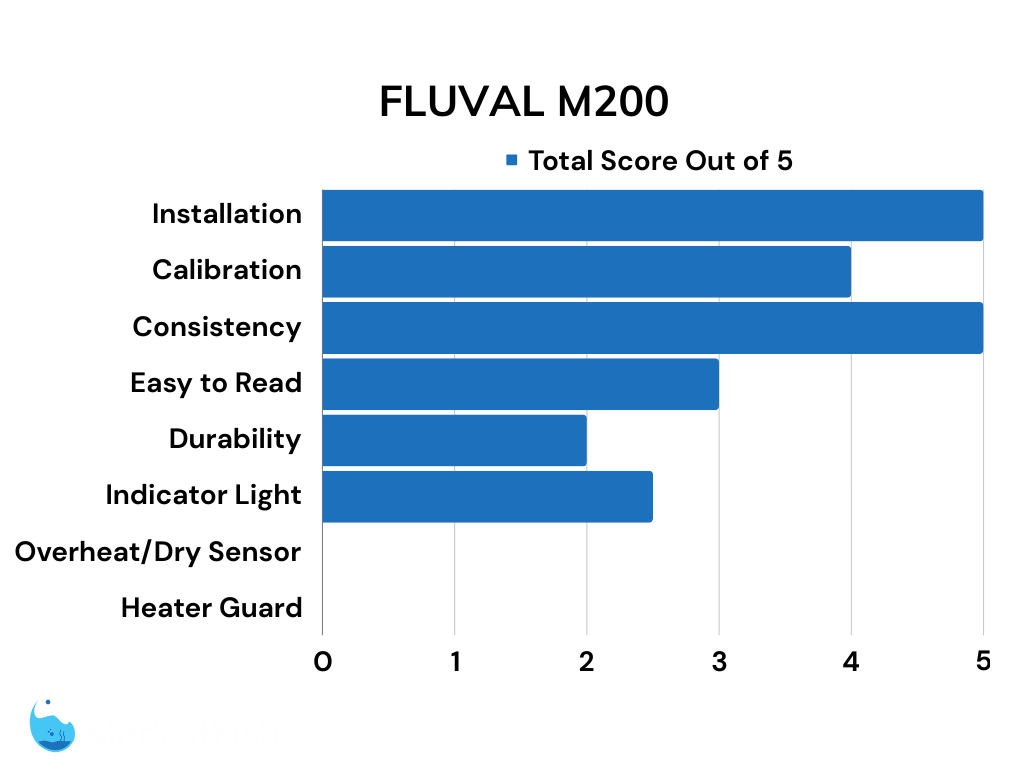
Pros:
- Slim, modern look
- Easy to read temperature dial
- Super easy installation
Cons:
- No heater guard
- Glass heater that could crack
- No overheat or dry sensor

Last update on 2024-04-25 / Commissions Earned / Images from Amazon Product Advertising API
Read our full in-depth review for the Fuval M200 Submersible Heater
4. Eheim Jager Aquarium Thermostat Heater
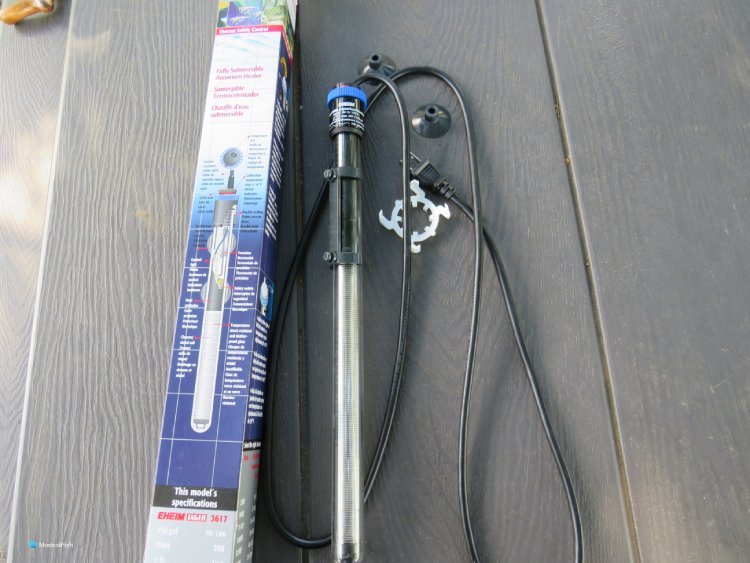
So, my first impression of this heater was that it’s absolutely huge! I was very surprised to compare it to my 300 watt Marineland heater and find that this 200 watt heater is several inches longer.
The Eheim heater comes with a simple bracket that you attach the included suction cups to and then simply stick the heater on the side of the tank.
This is a fully submersible heater, so you don’t have to leave any part of it out of the water. But, although installation was easy, it made me a bit nervous. Even in a 55 gallon tank, it felt like the heater was almost too big to be installed in the same part of the tank where my heater normally goes in the tank.
The tube is also bigger than the standard heaters I’ve used over the years. I really don’t think that you could get any kind of standard heater guard to fit over the glass tube.
I do like how large and easy to read the temperature dial is, but getting this thermometer calibrated can be tricky.
The temperature dial on this heater actually has two moving parts instead of one. The blue dial sets the temperature level of the heater, the red dial lets you calibrate the heater so that the temp you set the heater for matches the actual temp the heater warms the water to.

Yeah, I know that’s confusing at first glance.
It’s kind of hard to explain, but I’ll give it a go. Let’s say that you set the dial for 75°F, but the tank consistently sits at 78°F. You can actually turn the red indicator dial so that the arrow sits on the actual temp.
By making the red indicator dial match the actual temp, the heater dial should then be accurate. Then, the water temp should match up with whatever temp you’ve set on the dial.
Getting this heater to warm the tank to the proper temp was fairly challenging. I set the temp to 75°F on the dial, but this turned out to be 2°F too much. I turned the heat down a few notches, but then it was too cold. Then it was too warm again, etc.. Finally, after messing with it for the fifth time, I finally got the temp to 75°F.
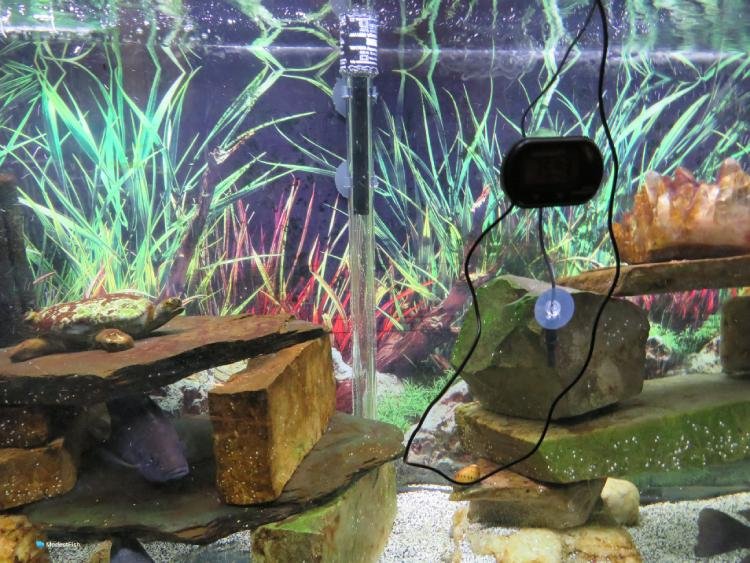
But, I can say that once you get this heater set to the correct temp for your tank, it does a great job of holding the temp steady.
This heater does not have an overheat sensor. If it’s in the water, there is no temp that will cause it to do an emergency shut down.
But, it does have a dry sensor that will shut the heater off if it leaves the water and will turn the heater back on once it’s returned to the water.
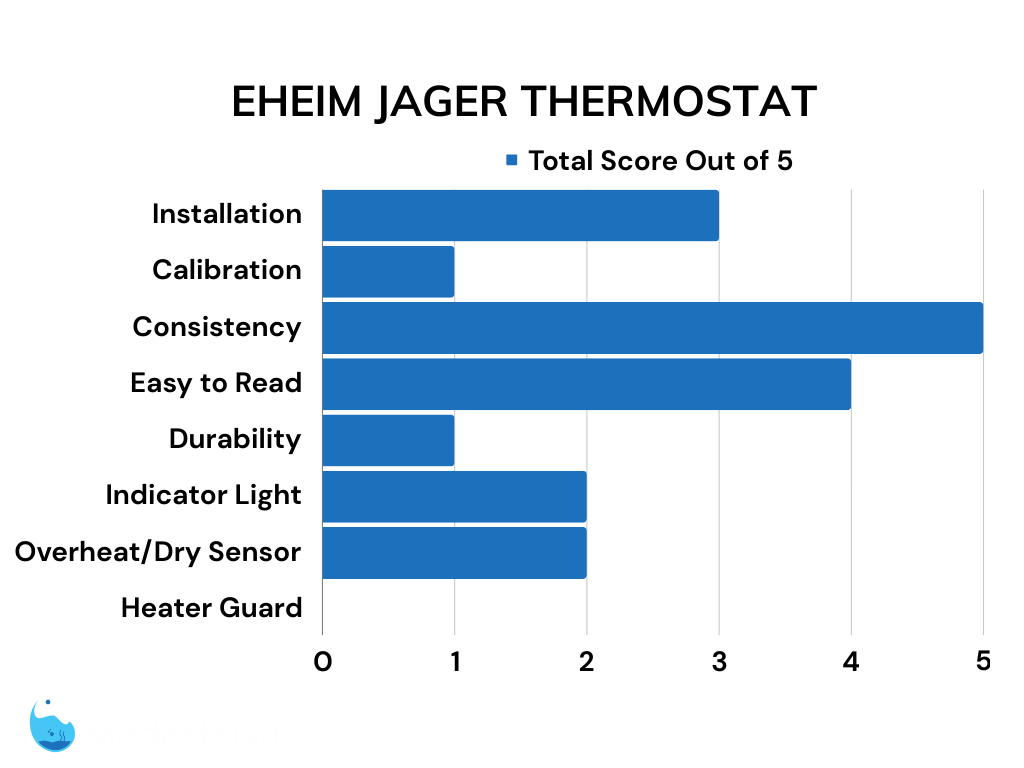
Pros:
- Indicator light turns on when heater is running
- Large, easy to read temperature dial
- Consistently holds a steady temp
- Dry sensor
Cons:
- Large size could make placement tricky
- Calibration can be frustrating
- Too big for most heater guards
- Glass construction may be vulnerable to cracking
- No overheat sensor

Last update on 2024-04-25 / Commissions Earned / Images from Amazon Product Advertising API
Read full review of Eheim Jager Aquarium Thermostat Heater
5. HITOP Adjustable PTC Aquarium Heater
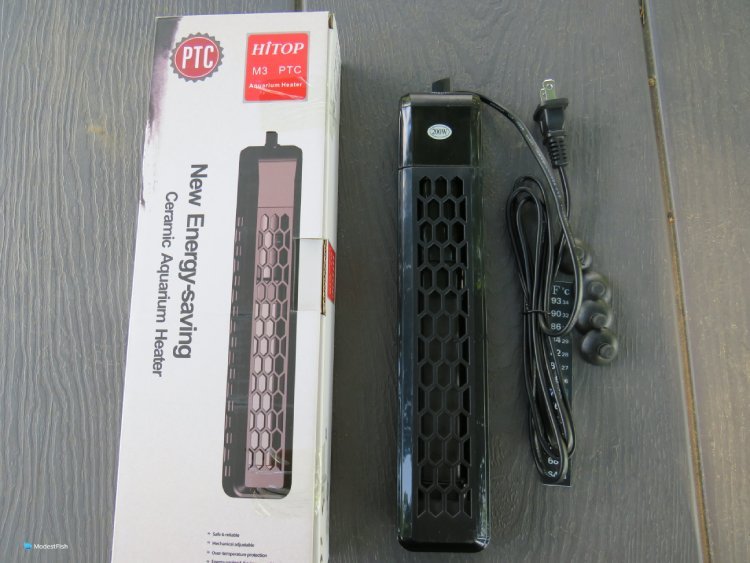
I have to mention that installing this heater was pretty difficult. You’re supposed to attach the suction cups to the heater guard by pressing a nub on the back of the cup through pre-drilled holes on the back of the guard.
This is pretty standard, lots of devices that utilize suction cups are like this, even several others on this list. But, these were insanely difficult to push through.
But, the holes are a bit too small, in my opinion, because it is really, really hard to get the nub on the back of the suction cup to go through.
After several failed attempts, I had to get my husband to try it. He’s a big, strong, blue collar guy and even he had to use a lot of effort, cursing and a small screwdriver to get them to go through.
Definitely, if you have any kind of trouble using your hands, you will need to ask someone to help you get this heater installed.
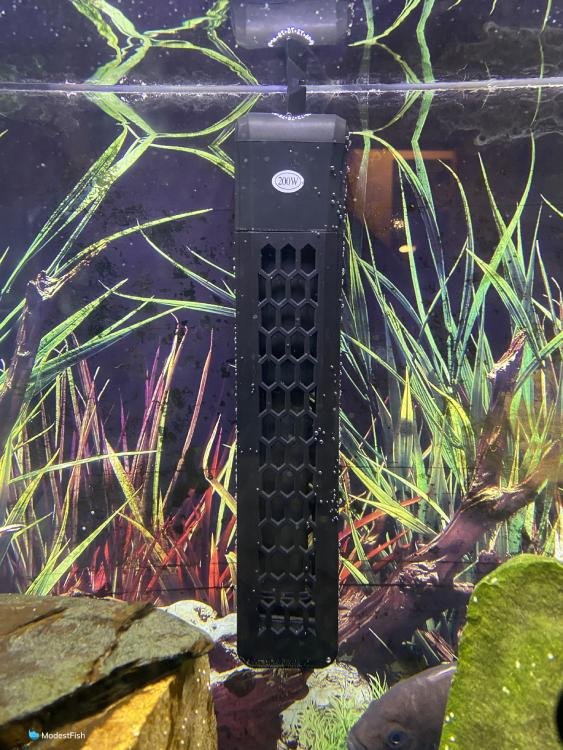
I do really like the heater guard on this model. It protects the ceramic heating element and should prevent most adult fish from ever touching it.
It also has an easy to read control dial on the top with clearly marked temperatures.
However, I don’t think the ceramic heating element has enough surface area to heat a 55 gallon tank. I had to keep bumping up the heat using the dial.
I had to adjust the heat until the dial was set on 79°F to get the water temp to stay at 75°F.
I think this heater would probably do great in a 30-40 gallon, but I think it struggles a bit on a 55.
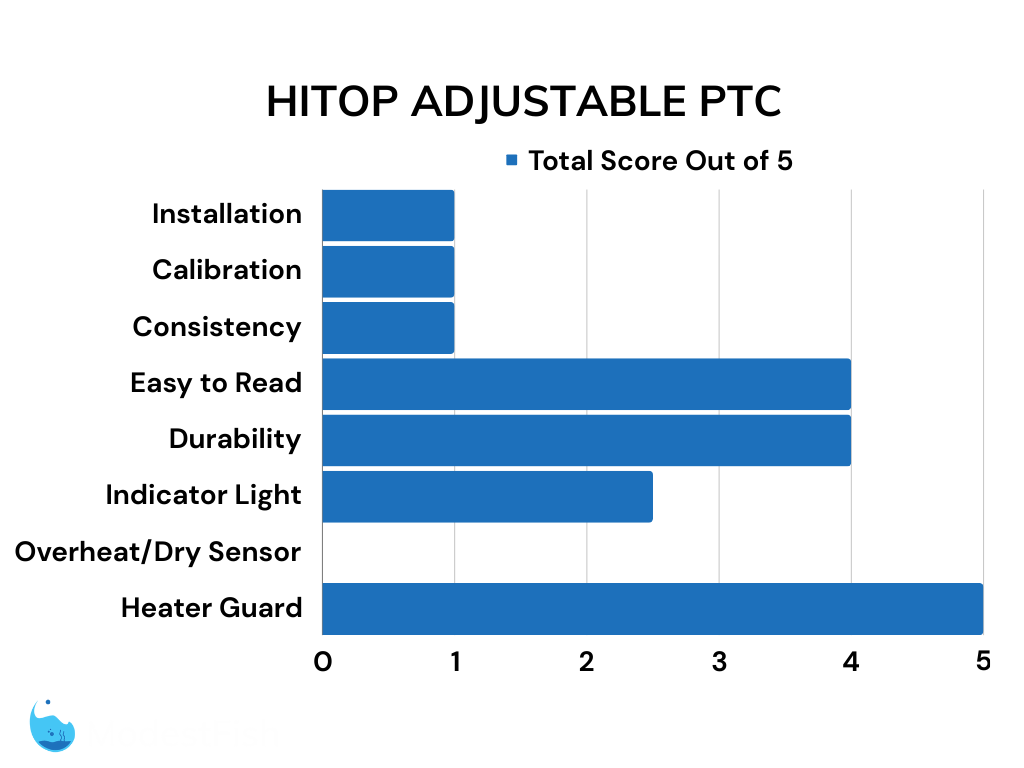
Pros:
- Easy to read temperature dial
- Built in heater guard
Cons:
- Installation was ridiculously difficult
- Underpowered

Last update on 2024-04-25 / Commissions Earned / Images from Amazon Product Advertising API
Read full review of HITOP Adjustable PTC Aquarium Heater
Which Aquarium Heater is Best?

So, the Fluval E200 was the clear winner of this head-to-head comparison.
It’s ridiculously easy to install, set and calibrate.
Of all the heaters that I tested, it was the set-it-and-forget-it model. I really like that it’s got a built-in heater guard to help keep adult fish safe.
Also, I LOVE that it has the digital display that lets you know whether it’s in standby or heating mode and will even alert you if there is a serious temperature problem in the tank.
That could be the difference between averting disaster and losing a tank full of fish.
If your tank is bigger or smaller than a 55 gallon, no problem! Fluval makes several different sizes of E heaters for you to choose from.
I think this is going to be my “go to” heater from now on. It really is that cool.
I wish you and your fish the very best!

Last update on 2024-04-25 / Commissions Earned / Images from Amazon Product Advertising API
How I Tested the Aquarium Heaters
Each heater was placed in one of my 55 gallon (208 liter) tanks and allowed to run for a week.
All five heaters are 200 watts, to make sure that I was making a fair comparison between brands and models. I also installed them in the same part of the aquarium to make sure that each heater was exposed to the same amount of water flow in the aquarium.
This tank is housed in a climate controlled room with an air temperature between 70°F and 72°F and the desired water temperature is 75°F (24°C).
Although I used 200 watt heaters on a 55 gallon tank, most of these heaters are available in smaller and larger wattages that would work for different tank sizes.
I specifically judged the heaters on the following criteria:
Installation – how easy or difficult was it to install the heater in my tank? Were the suction cups high quality and strong enough to keep the heater in place?
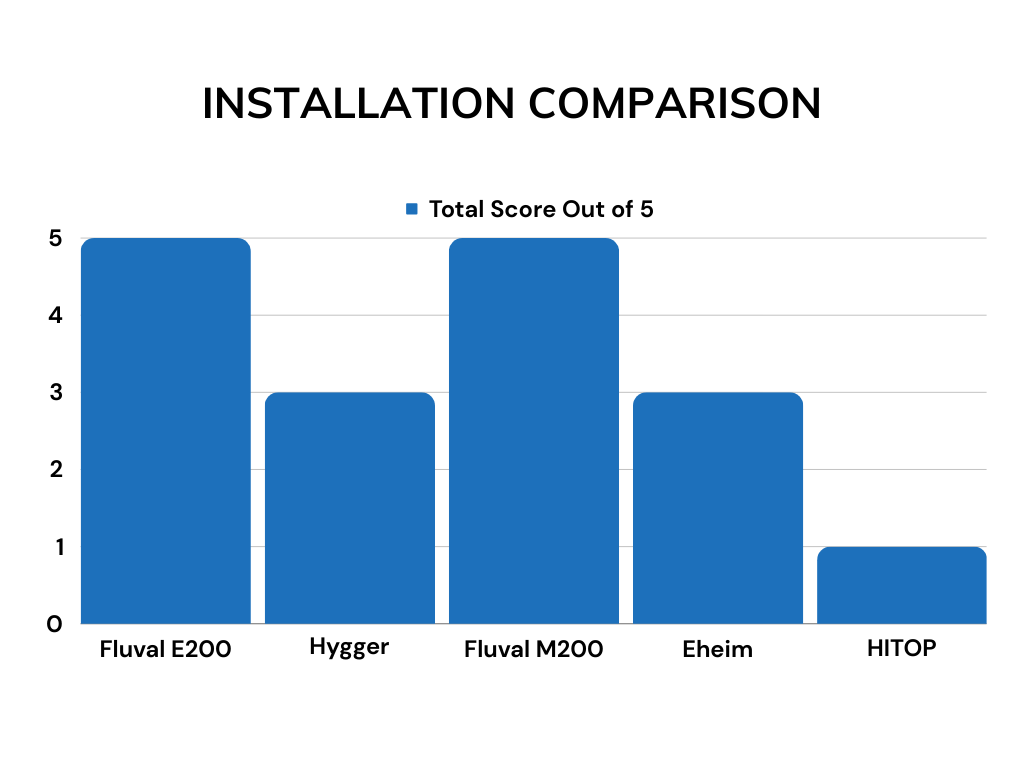
Calibration – how easy or difficult was it to get the heater set to a level that kept the water at 75°F (24°C)? Did I have to mess with the heater repeatedly to get the tank at the right temp or could I just set it and forget it?
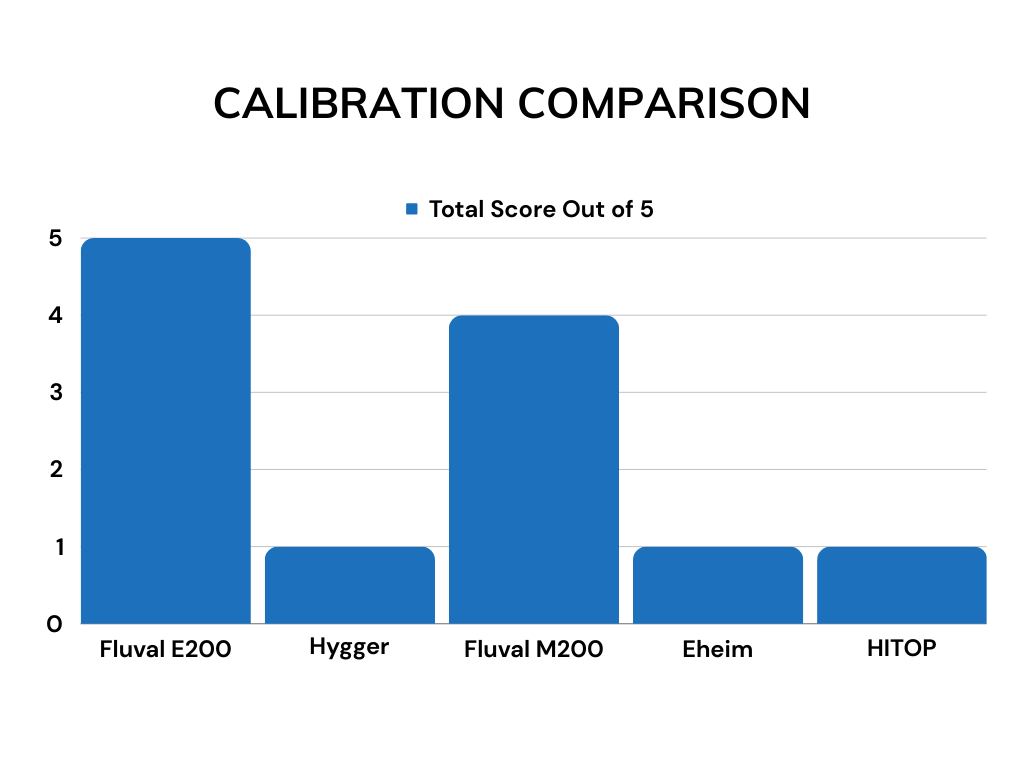
Consistency – was the heater able to maintain a steady 75°F (24°C) in the tank?
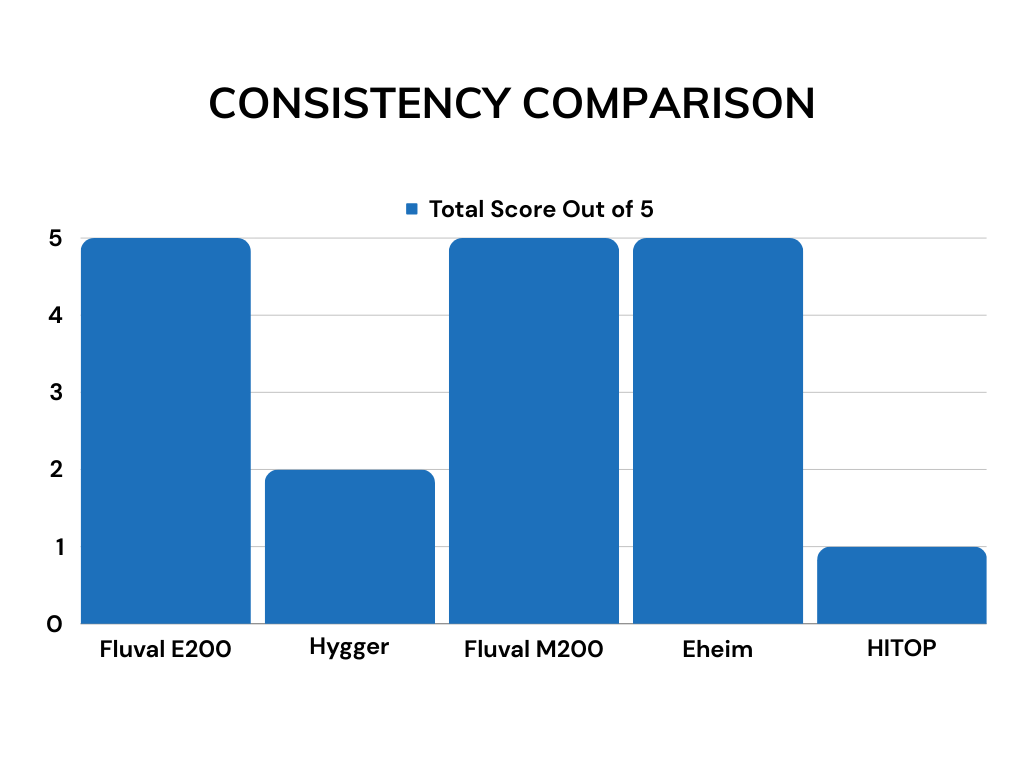
Features – does the heater have these features and how well do they work?
Easy to read temperature settings – can you easily tell what temperature you’re setting the heater on?
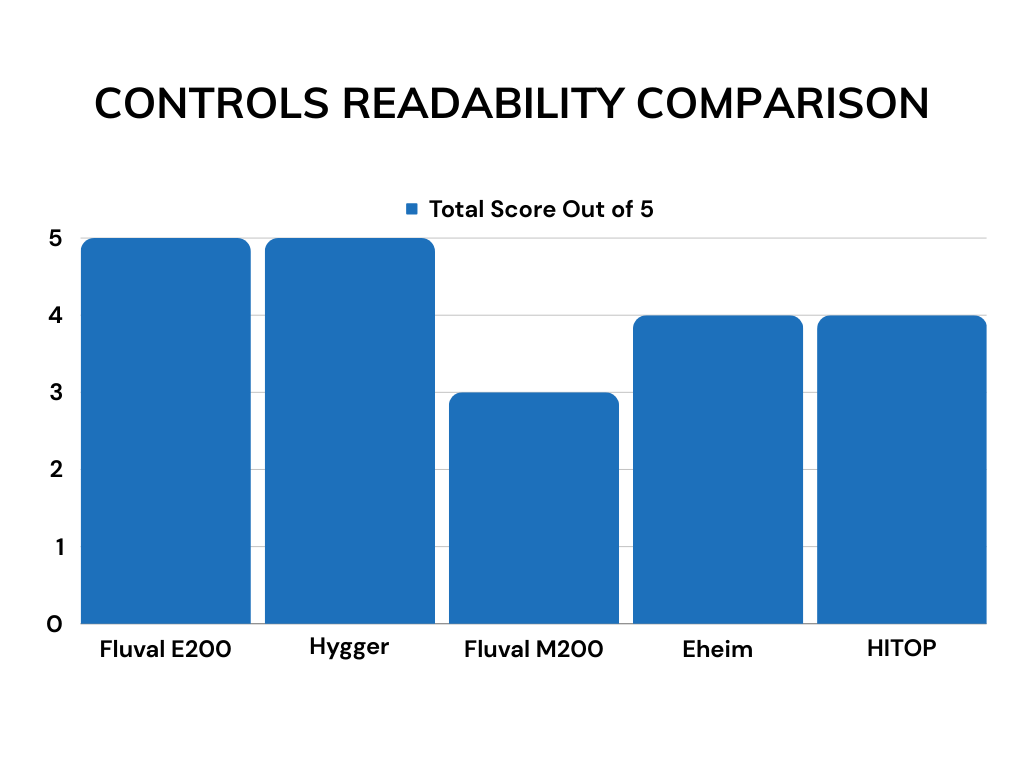
Durability – heaters can have exteriors made of glass, ceramic, plastic or titanium. Glass and ceramic are the most vulnerable to cracking or shattering.
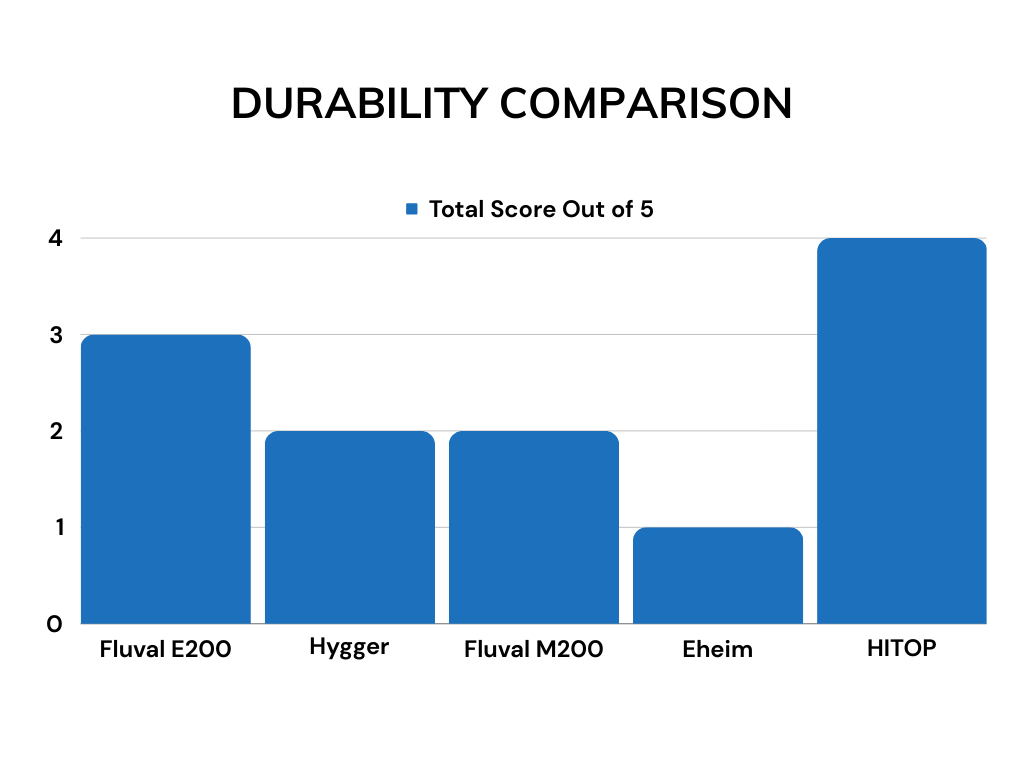
Indicator light – does the heater have indicator lights that let you know it’s in standby versus active heating mode? Does it only have a light for active heating mode? Or does it have no indicator lights at all?
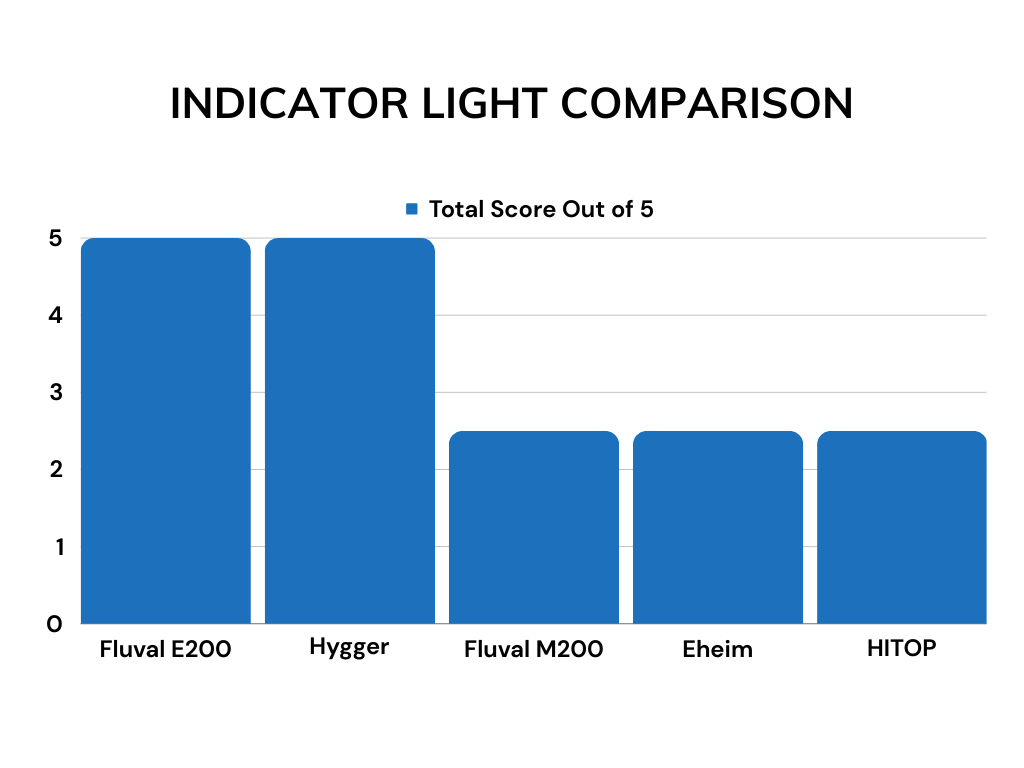
Overheat/dry sensor – does the heater have an automatic shutoff if the heater gets too hot? Does it have a sensor that will shut the heater down if it is running out of the water?
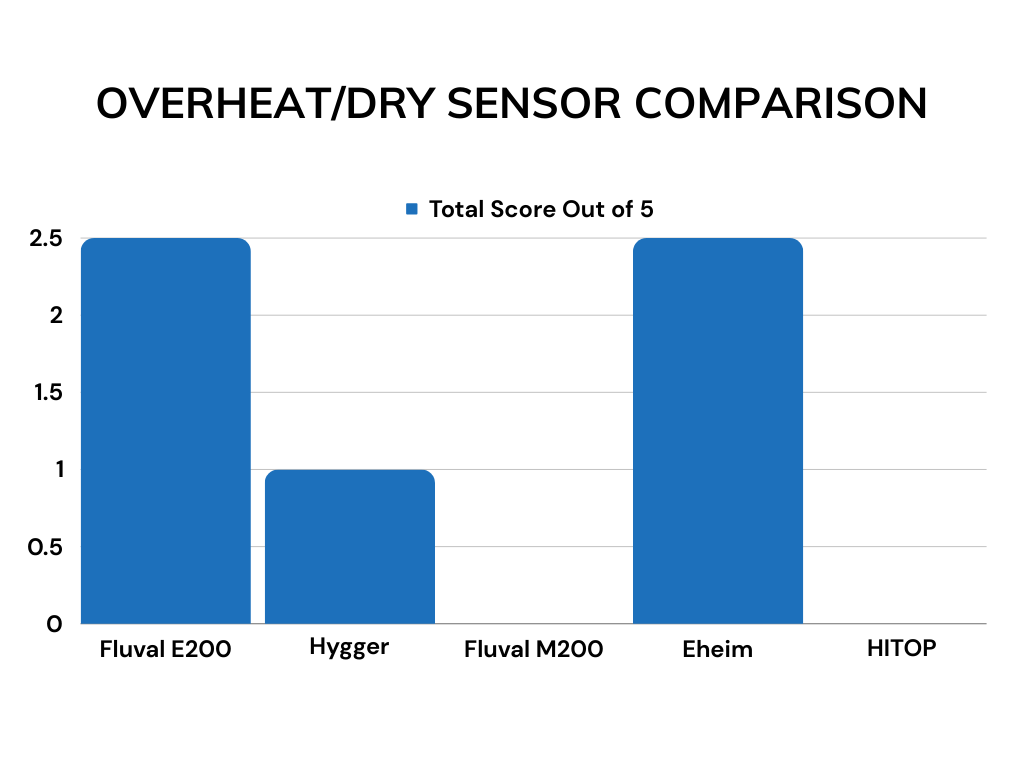
Heater guard – does the heater have a plastic guard that will keep fish from touching its surface?
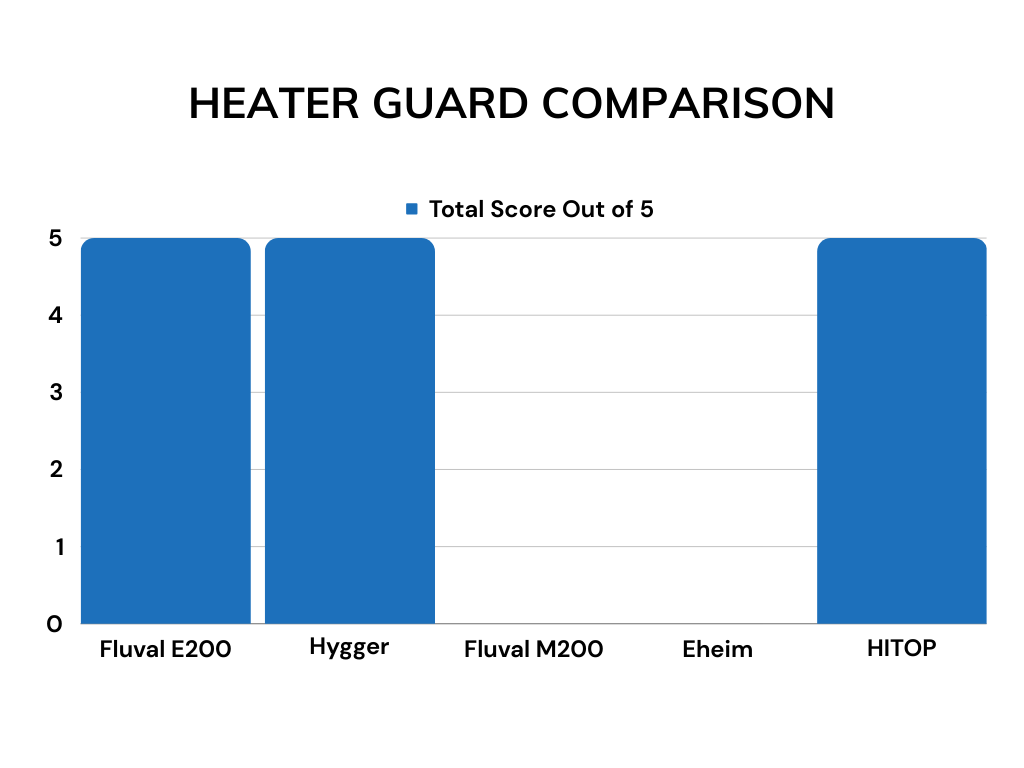
These factors were graded on a scale of 1-5, with 1 being the worst and 5 being the best.
If a heater doesn’t have a given feature, I gave them a zero for that category on the charts below. So, it may look like some categories are missing, but it’s just because the feature wasn’t there to grade.
And for indicator lights, heaters with one indicator light got a 2.5 and those with two got a score of 5.
How to Choose an Aquarium Heater For Your Tank
Available Wattage vs. Tank Volume
It’s really important to choose the right size heater for your aquarium.
If a heater is too small, it will struggle to maintain the proper temperature, will have to run constantly and will most likely wear out much quicker than normal.
If a heater is too large, it may overheat the water or cause large temperature swings.
So, the heater that works for a 30 gallon (113 liter), won’t work for a 55 gallon (208 liter).
Heaters come in many different power levels, which are defined by wattage. The higher the wattage, the more powerful the heater is.
The usual basic formula that folks have used for a long time is 3-5 watts per gallon (2-3 watts per liter).
To narrow down what size heater you need, you just need to know the volume of your tank and how many degrees the heater will need to raise the temperature of the water.
For example, if you had a 20 gallon tank, the room it’s in 70°F (21°C) and you want the tank water warmed to 75°F (24°C), then a 60 watt heater should be just right.
But, if you wanted the tank at 75°F and the room temperature was consistently 60°F (16°C), you would need a stronger heater to keep up with that much of a temperature difference. So, a 100 watt heater would be more appropriate.
Consider using more than one heater in the tank for aquariums 55 gallons (208 liters) and up and/or if the room is 10°F colder than your desired tank temperature. Also, if one heater fails, you can limp along with the other heater temporarily until you can get a replacement. Much preferable to having no heater at all.
Adjustability
You want to be able to adjust the temperature settings on your heater. Sounds silly, I know, but some heaters come with a set temperature. If you need to change the temperature for any reason, it becomes impossible.
Access to the Controls
Again, sounds obvious, but if you don’t make sure you’re able to easily adjust your heater underwater, it can be a very frustrating process. You want to look for heaters with a large control knob which is easy to grab and twist when submerged.
Temperature Readability
The best heaters you can buy have numerical temperature gauges. You’ll want to make sure you’re easily able to view this number.
Remember, this number may not always be accurate, it’s good practise to have a thermometer as well.
Safety Features
Firstly, make sure the heater you’re buying is fully submergible, most of them are, but it’s best to make sure. Automatic shut off features are very good. These will automatically turn the heater off when the water level gets too low, or the temperature of your tank gets too high.
A light indicator is the next safety feature I like to see. This means that the heater has a light when it’s on and when it actually heating. You’ll want to know if your heater is actually on or you’ll have to constantly monitor it.
Do You Need an Aquarium Heater?
Well, that depends.
Some species of fish don’t need a heater and will be perfectly happy with room temperature water, like goldfish or white cloud mountain minnows.
This is also true of dwarf freshwater shrimp, like cherry or crystal shrimp.
But, most of the fish in the aquarium hobby come from tropical regions that are much, much warmer than the average room temperature. They need temps anywhere from 75°F (24°C) to 82°F (28°C).
They will die if they are kept in water that is too cold for them.
So, you absolutely need to add a heater to any tank with tropical fish.
Please, carefully research any species of fish you plan to keep. That way, you know what kind of temperature and water parameters they’ll need to thrive in your tank

What Heater do I need to purchase for 17L Tank for Betta Fry ?
You can take a look at our article here on heaters for betta fish specifically: https://modestfish.com/betta-fish-heater/
Personally I would recommend a heater like the Fluval because the guard will protect your fry.
I like your suggestion of 2 heaters. In doing so, would you suggest downsizing the wattage. For a 75 gal tank would you go with say 2- 200’s as opposed to a 300?
Hi Rick. Yes. Two lower wattage heaters would be preferable. Since there are two heaters in this tank, they should be able to provide stable heating across the length of the aquarium without overtaxing anything
Great research!!! I went through a similar process and determined the best solution was to buy the cheapest metal meater, set it to maximum and controll it through a n external temp controller. Much more accurate and cost effective…less than half the price of any of these heaters. Been doing it in 3 large(75 and above) tanks for years.